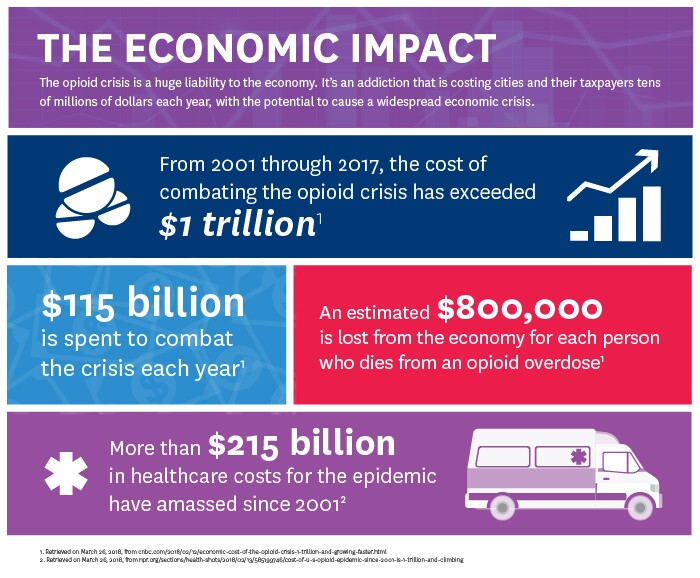An opioid crisis has been building in the United States for quite some time. While abuse of and addiction to this drug have long been issues in American communities, they’ve now reached dire new levels of urgency. Today, this epidemic is killing more people than ever before while simultaneously bankrupting cities and communities. It’s clear that this is a problem that can no longer be ignored, particularly by those in the healthcare industry who must lead the societal charge to pool intellectual and economic resources to combat this crisis.
Opioids are both legal (prescription) and illegal drugs that interact with receptors in the human nervous system, prompting favorable sensations in extreme doses, and they are often used as pain relievers or antidepressants. However, the body can become immune to the drugs’ effects, creating a chemical dependency in which users require increasingly higher dosages to achieve previous feelings.1
The opioid crisis has caused devastation at several levels—for individuals, families and entire communities. While our lawmakers have begun to confront this situation, a general awareness of the statistics behind this deadly and growing epidemic is still crucial for everyone.
The Physical Impact

The number of deaths attributable to opioid addiction is extremely concerning, and it is increasing more and more as each year goes by. Because opioid drugs are so addictive, people will often turn to the street versions of them—heroin or a bootlegged opioid called fentanyl.2 The results of these addictions have been physically devastating for families and communities across the country.
1) Opioid deaths went up 17 percent from 2016 to 20173
2) 66,324 deaths from opioid use were reported in 20173
3) Drug overdoses are now the leading cause of death for people under the age of 554
4) Over 23,000 deaths from synthetic opioids occurred from 2016 to 20173
5) 14,647 deaths from prescription opioid overdoses occurred from 2016 to 20173
The Economic Impact

The Statistics Behind This Growing Epidemic
The opioid crisis is a huge liability to the economy. It’s an addiction that is costing cities and their taxpayers tens of millions of dollars each year, with the potential to cause a widespread economic crisis.
1) From 2001 through 2017, the cost of combating the opioid crisis has exceeded $1 trillion5
2) An estimated $800,000 is lost from the economy for each person who dies from an opioid overdose5
3) $115 billion is spent to combat the crisis each year5
4) More than $215 billion in healthcare costs for the epidemic have amassed since 20016
Ready for a Change?
Those in the health industry have the ability to help us tackle the opioid epidemic once and for all. By educating yourself and others, we can figure out the best ways to approach the problem and, in time, defeat it.
To begin developing the professional health knowledge required to face social challenges like this, consider the Kent State University online Master of Public Health.
- Retrieved on March 26, 2018, from cnn.com/2017/09/18/health/opioid-crisis-fast-facts/index.html
- Retrieved on March 26, 2018, from drugabuse.gov/drugs-abuse/opioids/opioid-overdose-crisis
- Retrieved on March 26, 2018, from usnews.com/news/national-news/articles/2017-12-15/drug-overdose-deaths-continue-to-soar
- Retrieved on March 26, 2018, from nytimes.com/interactive/2017/12/22/upshot/opioid-deaths-are-spreading-rapidly-into-black-america.html
- Retrieved on March 26, 2018, from cnbc.com/2018/02/12/economic-cost-of-the-opioid-crisis-1-trillion-and-growing-faster.html
- Retrieved on March 26, 2018, from npr.org/sections/health-shots/2018/02/13/585199746/cost-of-u-s-opioid-epidemic-since-2001-is-1-trillion-and-climbing
